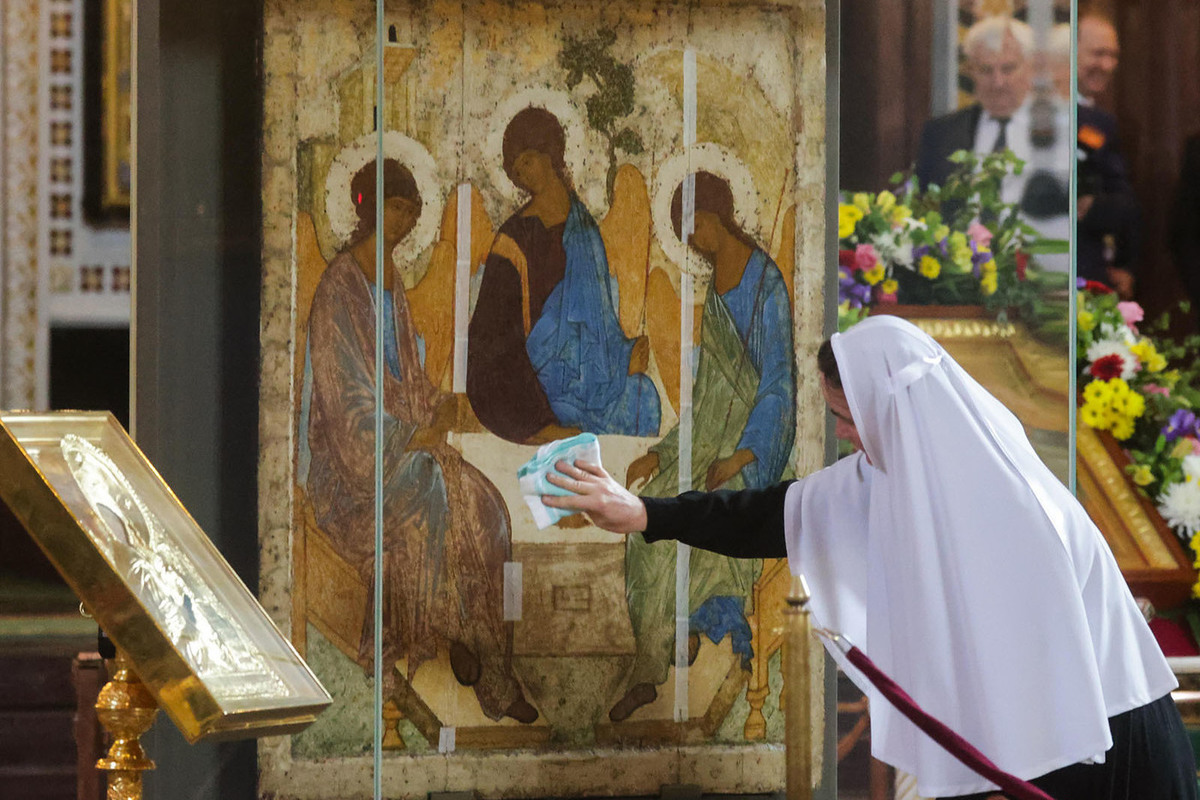Clarified the details of the preparation of the Trinity-Sergius Lavra for the reception of the “Trinity”
[ad_1]

The executive director of the Sergiev Posad Historical and Art Museum-Reserve Alina Saprykina left her post a year after her appointment. As she told MK, this is due to the fact that the museum is moving from the subordination of the Ministry of Culture of the Moscow Region to the federal one. Therefore, the Ministry of Culture of the Russian Federation puts its own person – Natalya Grigorieva, who until April of this year headed the Novgorod State Museum-Reserve.
In the light of recent events around the icon of the Holy Trinity, this seemingly unremarkable rearrangement acquires an important meaning. It seems that the department is preparing the conditions for a fragile icon, which will sooner or later be transported from the Grabar Restoration Center to the monastery of St. Sergius of Radonezh. Let’s look into the details.
The Sergiev Posad Museum-Reserve includes several sites: exhibition halls on Red Army Avenue, the Horse Yard Museum Complex, which shows folk and decorative and applied art, archeology, history, the Local Lore Corps dedicated to the history of the city, and, most importantly, the Sacristy Trinity-Sergius Lavra, located on its territory.
The museum has a magnificent collection – more than 200 thousand exhibits. It was founded in 1920 – after the closure of the Lavra and the eviction of the brethren. Understanding the inevitability of this decision, even before the closing of the Lavra, with the direct participation of Igor Grabar, they created the Society for the Protection, Study and Publication of the Artistic and Historical Treasures of the Trinity-Sergius Lavra, and then a museum that should preserve church values. At the same time, the “Trinity”, which was originally cleared within the walls of the monastery, leaves the Lavra and goes to Moscow.
However, the collections and expositions of the museum contain not only church relics, but also archeological monuments, paintings (in Soviet times, many artists moved here after exile or from unwillingness to write what was prescribed by the official party line), a lot of ceramics and arts and crafts.
Since the beginning of the 20th century, a lot of water has flowed under the bridge, and the current general director of the museum, Metropolitan Feognost (Guzikov), who combines many duties under the ROC, has long understood that the museum with all its buildings needs to be rebooted, a more modern and interesting exposition format for tourists.
To do this, he personally invited Alina Saprykina to the museum, who at one time (as a PR person) launched Garage, headed Artplay and Moscow Museums, and until last summer was the chief curator of the All-Russian Museum of Decorative Arts.
Saprykina has a reputation as a person who is able to make any space popular and interesting, behind her work with large projects and territories. It was immediately clear that the development of the project to reboot the Sergiev Posad Museum would take several years.
By this summer, Alina had already managed to prepare the ground for the renewal of the museum entrusted to her, but big politics intervened in the plans. Good relations have been established with Theognost for a year, but the plans will have to be urgently reviewed, because now the museum now has a super task – to take part in the preservation of the most important monument of ancient Russian art. Alina did not remain without work – she leaves for the Ministry of Culture near Moscow. The feds put in their man. Why Natalia Grigorieva?
For 13 years Natalya Grigoryeva was in charge of the Novgorod Museum-Reserve, the largest complex in Russia that preserves monuments of ancient Russian culture. Among them are the works of Andrey Rublev’s teacher, Theophan the Greek.
The Church of the Transfiguration on Ilyina Street with its fresco of Christ the Almighty (1378) is under the jurisdiction of the museum (it is an object of federal significance). And not only it, but also many other ancient temples that are no longer in operation. In total, the museum stores about 650 thousand exhibits, among them the oldest surviving icons and frescoes, the earliest dating back to the 11th century.
The museum, founded in the second half of the nineteenth century, has a strong restoration department, organized in 1925. However, the experience of preserving ancient monuments in Veliky Novgorod began to be increased even earlier – from the end of the 19th century. And conservation, which is just what the Trinity needs, is one of the main activities in the Novgorod museum. That is, Grigorieva, just in profile, is a museum at the Trinity-Sergius Lavra.
Obviously, the Ministry of Culture expects, while the “Trinity” will “lie down” in the Grabar Center, to create the necessary conditions in the Trinity-Sergius Lavra. What can they be? This was discussed in detail at a round table at the State Institute of Art Studies, where all the leading specialists of the country were present offline and online.
We agreed that it would be ideal to arrange a separate room for the Trinity with the necessary conditions for the temperature and humidity regime, light, and organization of the passage of people.
It may take about a year to design and construct a special climatic showcase – it is no coincidence that Olga Lyubimova announced exactly this period for the icon to be in the Grabar Restoration Center. By that time, perhaps, it will be possible to agree on a place, because in the Trinity Cathedral there is really nowhere to put a fragile icon.
It is clear that the president’s decision to transfer the “Trinity” to the Russian Orthodox Church cannot be reversed, but it is possible to create “ground” for a comfortable stay of the 15th-century monument in the Trinity-Sergius Lavra. Probably, the current castling is needed precisely for this.
[ad_2]
Source link






